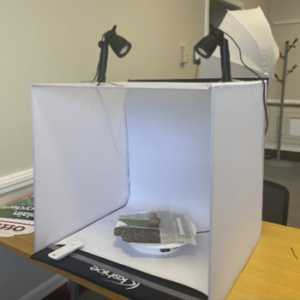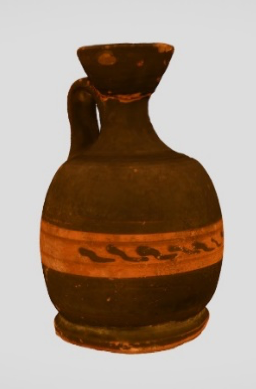By Lucy Rumble
This summer I undertook a two-week Roman Society Museum & Heritage Summer placement at the Institute of Classical Studies (ICS), University of London, under the supervision of Gabriel Bodard. I was tasked with continuing work started in 2019 to create 3D digitisations of items held within the Ehrenberg Collection. The collection comprises a variety of Greek and Roman artefacts spanning several centuries, which were gifted to the ICS by Victor Ehrenberg. The opportunity was a perfect fit for my own interests as I have just completed a BA in Ancient, Medieval and Modern History at Durham University, and am due to embark on the MA in Digital Humanities at UCL this autumn.
 Before I arrived at the ICS, Gabriel provided me with some video tutorials and suggested that I familiarise myself with the theory and practice of photogrammetry, the process of combining multiple 2D images to create a 3D model using specialised software. The tutorials provided me with sufficient knowledge to photograph the objects myself, and to merge them using Agisoft Metashape and Autodesk MeshMixer. Over the two-week period, I was able to successfully digitise six items from the library’s collection, putting aside a couple more after several failed attempts at producing a complete model. These latter items were similarly imaged from inside a light tent (shown above right), but their uniformly black surfaces proved too reflective for the software to accurately identify and so the model was repeatedly rendered with gaps. Through trial and error, I learnt that more detail often correlated with greater accuracy in the final 3D model as the software was able to detect a higher number of overlapping points.
Before I arrived at the ICS, Gabriel provided me with some video tutorials and suggested that I familiarise myself with the theory and practice of photogrammetry, the process of combining multiple 2D images to create a 3D model using specialised software. The tutorials provided me with sufficient knowledge to photograph the objects myself, and to merge them using Agisoft Metashape and Autodesk MeshMixer. Over the two-week period, I was able to successfully digitise six items from the library’s collection, putting aside a couple more after several failed attempts at producing a complete model. These latter items were similarly imaged from inside a light tent (shown above right), but their uniformly black surfaces proved too reflective for the software to accurately identify and so the model was repeatedly rendered with gaps. Through trial and error, I learnt that more detail often correlated with greater accuracy in the final 3D model as the software was able to detect a higher number of overlapping points.

Despite its largely black surfaces, this lekythos was successfully rendered due to the slight variation provided by the decorative orange band around its body and the chipped surface of the neck.

Digital model of sherd
Over the course of the second week, I attempted the task of digitising two objects which required every angle to be photographed (example left). While the bases of figurines and lekythoi did not need to be photographed, sherds and other fragments must be captured from every angle. To achieve this, I needed to create two models which showcased each half of the object. I could then “stitch” these together using Agisoft Metashape to create a complete model. This was the most challenging aspect of my experience, compounded by the software which took a considerable time to run through each element of the digitising process.
As a technique, photogrammetry is hugely beneficial to recording our cultural heritage, and the published models provide a more interactive and widely accessible way of viewing physical objects within a collection. This manner of archiving historical data comes as a natural response to the digital age and emphasises the continued importance of preserving, cataloguing, and displaying such data. Uploading 3D models online maintains public interest in historical items and has the potential to reach a global audience. The ICS library set up its project with just these aims in mind. Indeed, the Sketchfab collection is particularly beneficial in this instance because the Ehrenberg bequest is a handling collection. Its objects are intended to be interacted with, but constraints on physical space and members of staff who can supervise such handling mean that it is not possible to do so every day. Digitisation therefore removes these constraints and will eventually allow every item within the Ehrenberg collection to be accessed online. It was a privilege to contribute to this important work.
My contributions were not only beneficial to ongoing work at the ICS, but also provided me with valuable experience in this aspect of digital humanities ahead of my postgraduate course. The opportunity to work largely independently greatly increased my confidence, and I found photogrammetry relatively easy to pick up with rudimentary knowledge of photography. Particularly useful was the link Gabriel provided to a document recording ongoing difficulties encountered during photogrammetry. Not only did this emphasise the relative novelty of my work, but also encouraged me to experiment with both the photography and software elements of the process. The reward of finding my own solutions and the ability to contribute something tangible to the ICS library’s ongoing digitisation project were most valuable.
This two-week placement at the ICS provided me with an enjoyable and valuable insight into the field of digital humanities. It pushed me to work independently and equipped me with the skills and confidence to tackle new digital tasks. I am grateful to the Roman Society for their organisation and funding and to Gabriel and the staff at the ICS Library for their welcome and support. I am excited to continue my work in the digital humanities field, and I hope that my contributions to collections at the ICS are helpful to future scholars.
Digitised items from the Ehrenberg Collection can be viewed at https://sketchfab.com/harlehrenberg

